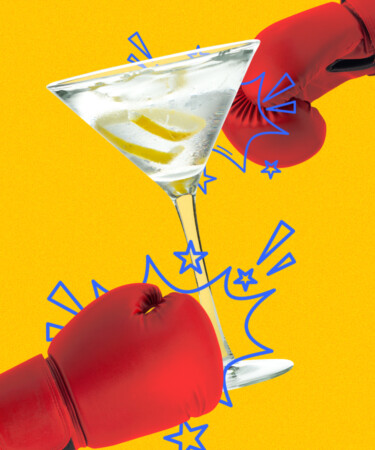Shaken or stirred?
When it comes to preparing a cocktail, both methods of combining ingredients are beneficial for dilution, marrying together delicious flavors, and creating the desired texture. When it comes to shaking a cocktail, the greatest benefit comes from aeration, forcing air into the mixture, which, in turn, helps to create a smooth mouthfeel and velvety texture. So, why is it that there is such a hot debate in the cocktail world surrounding whether gin cocktails should ever be prepared this way?
If you’re James Bond, a Martini’s always going to be shaken, but if you’ve spent any time around certain beverage professionals in the last few decades — or any time on the internet, for that matter — you may have heard a rumor that this method of preparation actually bruises the gin. But what does this mean? And further, is this rumor even true? Is 007 wildly incorrect when he orders his famous Vesper shaken, not stirred? To get to the bottom of these questions, VinePair spoke with Grant Sceney, creative beverage director of Fairmont Pacific Rim, for more information.
“Bruised gin comes from the myth, or belief, that the delicate flavors in gin are lost when it is aerated through the shaking process, in turn making the spirit taste more bland, which can diminish the subtle flavors,” he explains. “This myth likely arises from the fact that gins weren’t always made to the highest quality that they are today, and the same goes for the quality and consistency of the ice that was used to make the drinks and the techniques used by bartenders back in the day.”
According to Sceney, shaking lower-quality gin with ice may have caused the resultant cocktails to become over-diluted when they were made in the past, therefore giving rise to the assumption that shaking any gin cocktail “bruises” the spirit. In reality, it’s more likely that the spirits and techniques used historically weren’t high caliber enough to maintain the flavor and textural characteristics of the gins used.
Sceney explains that “bruising” is the incorrect term to use when it comes to describing a potentially altered flavor profile. It’s possible to over-dilute a gin Martini, for example, by shaking it, as more ice, water, and aeration can make the subtle flavors present harder to detect, but he stresses that this doesn’t mean the spirit is bruised — it just means the cocktail is a bit watered down.
So, shaken or stirred? In Sceney’s opinion, a good rule of thumb when it comes to cocktail prep is analyzing the ingredients you will be using. “If the ingredients are similar in density and viscosity — for example, gin and vermouth — then stir them and gently blend the flavors together,” he instructs. “However, if they vary in density and viscosity — for example, gin, lime juice, and sugar syrup — shake them vigorously to bring them all together at the same balance.”
Sceney stresses that there are certainly ways to use gin incorrectly and not get the best out of the spirit, but it won’t technically bruise it in any way. “At the end of the day, drinking should be fun and enjoyable,” he says. “If you prefer a shaken gin Martini, go for it. You’re the one drinking it after all, not the bartender.”
